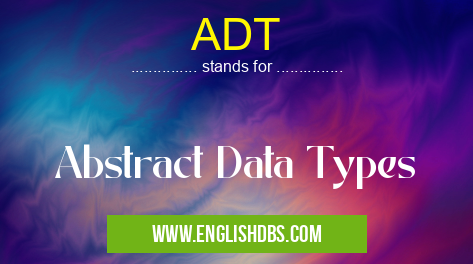What does ADT mean in UNCLASSIFIED
Abstract Data Types (ADT) are a cornerstone of computer science. They provide a way to logically structure data and enable development of more efficient and modular software components. An abstract data type is a model of a class of entities and the operations that can be performed on them, without giving any implementation details about how the operations are implemented. In other words, ADTs allow for the creation of complex data structures that can be shared between various software components while keeping most of their concrete implementation hidden from view.

ADT meaning in Unclassified in Miscellaneous
ADT mostly used in an acronym Unclassified in Category Miscellaneous that means Abstract Data Types
Shorthand: ADT,
Full Form: Abstract Data Types
For more information of "Abstract Data Types", see the section below.
Definition
An abstract data type is an organized set of data values and associated operations defined independently from their concrete implementation. By allowing us to encapsulate our data in this way, ADTs provide us with an intuitive way to think about our code design and make it easier for us to reason about the behavior of our programs.
Benefits
The benefits of using an abstract data type are numerous. By separating the representation of objects from the operations associated with them, we can create systems where different programs can communicate and share information without caring about each other's underlying implementations. Similarly, ADTs allow for better automations when accessing certain types of data; by providing methods that act on objects in a canonical fashion, elements in lists or dictionaries can be processed without worrying about figuring out how they were actually stored in memory or elsewhere. Finally, they offer better flexibility when switching implementations as only small parts need to be adjusted instead re-implementing the entire system from scratch.
Essential Questions and Answers on Abstract Data Types in "MISCELLANEOUS»UNFILED"
What is an abstract data type (ADT)?
An abstract data type, or ADT, is a theoretical model of what a data item can do, rather than how it is implemented. It serves as the basis for many programming languages and is used to describe the internal characteristics of a program. The ADT contains operations that can be performed on the data structure and has rules which define how each operation works.
How is an ADT different from a data structure?
A data structure is an implementation of an ADT - it defines how the items are physically stored in memory or other media. An ADT, however, specifies only the way that operations are performed on the items without dictating how they are stored or accessed.
What benefits does using an abstract data type bring?
Abstract Data Types give programmers flexibility when designing applications. Since they don't need to worry about the specifics of implementation, they can design more efficient algorithms which are easier to understand and maintain. Additionally, since these types are more generic they can often be applied across multiple languages and platforms with minimal changes required.
Where would I use an abstract data type?
Abstract Data Types can be used in any situation where you want to represent information in a generic way without needing to know the details of its physical storage or implementation. This includes databases, distributed systems, graphical applications, mobile apps and many other domains where flexibility and scalability are important considerations.
Are there any drawbacks to using an abstract data type?
One possible disadvantage of using an abstract data type is that certain operations may have higher overhead than if you were dealing with specific implementations directly. Another potential drawback is that developers may need additional training or expertise in order to fully understand and work with them efficiently.
Is there one standard definition for all abstract data types?
No - each language has its own set of conventions regarding how to define and implement ADTs so it's important for developers to understand their specific language's methodologies before attempting to use them in their projects. Additionally, depending on the needs of your project different definitions may be more suitable than others so careful thought should go into choosing the right one for your particular application context.
Are there any tools available for working with abstract data types?
Yes - depending on your development platform there may be libraries or frameworks available that make working with ADTs easier by providing convenience methods for creating complex structures like linked lists or trees quickly and easily without having to write code from scratch each time you need them.
Final Words:
In short, abstract data types provide developers with an efficient way to create software components that can communicate amongst themselves while hiding their internal details from view. This allows us greater flexibility when it comes to creating large systems that need to communicate whilst offering improved efficiency when processing complex datasets. With its various benefits such as robustness, scalability and modularity, abstract data types remain one of the most important concepts in computer science today.
ADT also stands for: |
|
| All stands for ADT |
